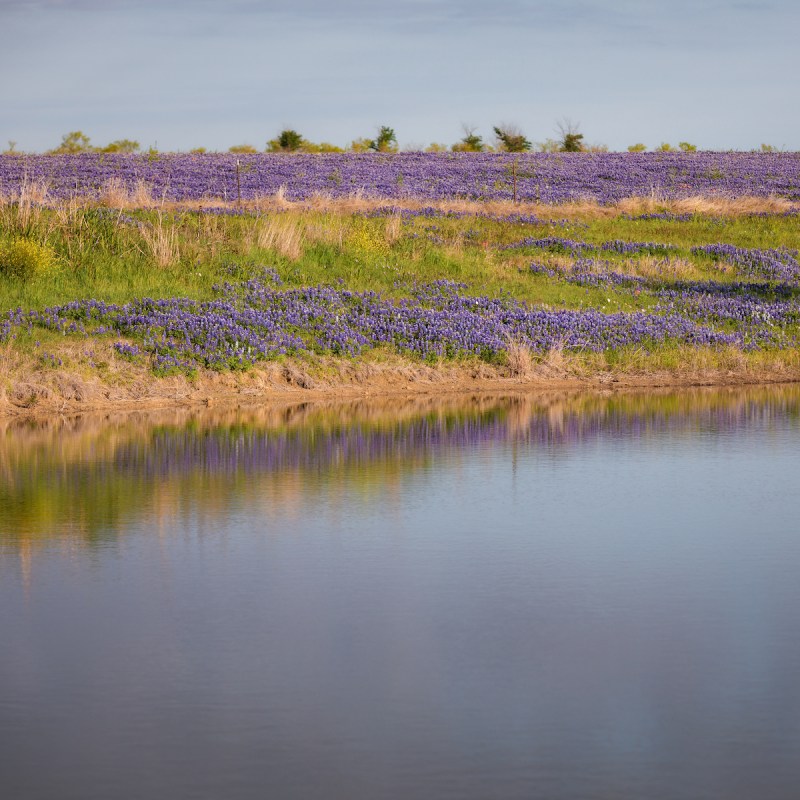
There is something magical about driving and seeing the eye-catching beauty of wildflowers on both sides of the road. It’s what makes an ordinary road trip more the merrier.
Videos by TravelAwaits
Each year around the first of April, beautiful wildflowers start popping up all over Texas, and many wonderful wildflower drives occur by Texans and out-of-state travelers. Texas has over 5,000 species of wildflowers, but the most common ones are bluebonnets (Texas’s state flower), Indian paintbrush, pink evening primrose (known as a buttercup to Texans), Indian blankets, Texas bluebell, dandelion, brown-eyed Susan, white prickly poppy, and about twenty more.
I have many memories as a child playing with wildflowers and took for granted that they would always be around. Sometimes when walking by a dandelion, I pick it and make a wish. Wondering now if other Texans do that. Or all those times I would tell someone to smell a buttercup only to leave tiny bits of yellow matter on their noses. Then we would laugh.
If planning accordingly, there are several wildflower festivals to catch in a few of the small towns listed below. Springtime is definitely an awe-inspiring season to visit Texas and to play in the fields of wildflowers. Here are nine of the state’s best wildflower drives to explore for rich beauty and excellent photo opportunities.
In general, the best time to see fields of wildflowers in Texas is March through May, with the peak season being in April.
1. Northeast Texas
Linden, Avinger, Hughes Springs
A showcase of beautiful yellow fringed orchids, coreopsis, Indian paintbrush, phlox, and other wildflowers are sprawled out over this 40-mile triangle route through these tri-cities. This drive gives you a taste of what is to come on the expanded 128-mile route along Highways 43 and 49 down to Marshall and back up to Linden, should you want to continue. There are massive wildflowers such as the coneflower, dogwoods, field pansy, bachelor buttons, bluebonnets, and more to see. Wow, to me, that’s worth going the full route. Some of these flowers, I buy to plant in my flower pots and garden at home! The tri-cities host an annual Wildflower Trails of Texas celebration in Linden on the fourth weekend in April.
Tip: After exploring this area and before heading back to Linden, you may want to stop in the quaint town of Jefferson to get a photo of yourself in front of the iconic blue truck that’s parked downtown.

2. East Texas
Palestine, Rusk, Alto, Nacogdoches, Crockett
On this drive, you’ll wind through these towns spotting beautiful blooming trees, like the dogwood and the redbud, along with winecups and other wildflowers. If you start in Nacogdoches, you’ll drive through the Davy Crockett National Forest, then onto Crockett, then to Palestine, making your way back to Nacogdoches. And, while in Palestine, you may want to visit Davey Dogwood Park to see the gorgeous bloomed-out dogwoods. If in the area in the middle of March through the first of April, catch the Texas Dogwood Trails Celebration.
3. Mrs. Lee’s Daffodil Garden
Gladewater
You may want to make a quick stop in Gladewater (East Texas) if you love golden daffodils. Beginning mid-February to March, you’ll see millions of them scattered all over Mrs. Lee’s Daffodil Garden. If you have any plans at all to visit the charming town of Tyler, Texas, for a weekend getaway, Gladewater is about twenty-five miles north and is worth a drive to see the lovely yellow dainty flower.
Tip: There is no cost to enter the garden, and you can walk around the garden at your leisure seven days a week.

4. Washington County
Brenham, Burton, Independence, Washington, Chappell Hill
On this route into Washington County, you’ll come across blankets of bluebonnets, Indian paintbrush, thistles, purple coneflower, verbena, and so many more wildflowers to many to name here. This area is one of my favorite places to visit for family fun, and it showcases some of the best of Texas’s spring wildflower scene.
My grandson and I went camping in this area, and we made a mad dash to charming Brenham, Texas, where we ordered a scoop of ice cream at the nostalgic Blue Bell Ice Cream Parlor for only $1.
Tip: If making your way for that $1 scoop of ice cream is on your to-do list (which it should be), take note that the ice cream parlor is not open on weekends.

5. Brazoria County
West Columbia, Angleton, Lake Jackson, Brazoria
Brazoria County is located in the Gulf Coast region of Texas. So, if visiting Galveston is on your bucket list, you could drive the wildflower route in West Columbia, Angleton, Lake Jackson, and Brazoria and then spend a great day in Galveston and possibly stay overnight. You can see spider lily, black-eyed Susan, bluebonnets, morning glory vine, and wild indigo along this route. Brazoria National Wildlife Refuge offers the sites of tropical sage, coreopsis, yellow thistle, and sea oxeye daisy if you have time.

6. Texas Hill Country
Lampasas, Burnet, Marble Falls, Johnson City, Fredericksburg
Aww, probably the most driven route in Texas. I say that because it’s a forgiving piece of land out there and known for many things like great weather, wanderlust, and wine, to name a few of my favorites! It’s always okay to drive with the top down while viewing the many wildflowers that grace Texas Hill Country.
My favorite backroad to take to get to the wonderful scenery, and the one you’ll want to take, is down Highway 281 to Lampasas if coming from the Dallas/Fort Worth area. Coming from any other area, Austin is nice, but try to avoid going through the city — and instead take the backroads. If you end up in Fredericksburg, Texas, which is not a bad place to end a gorgeous ride, check out Wildseed Farms for many Texas memorabilia and souvenirs.
Tip: Burnet hosts its annual Bluebonnet Festival in April.
7. Red Poppy Trail
Georgetown
Springtime is when all the little red poppies come out to play with Georgetown’s residents and visitors. I spent a fantastic weekend in Georgetown during the holidays and got a glimpse of what the town will look like in the spring. You guessed it — all red. If you love the color red, you’ll love their small-town vibe. Known as one of the best areas to see the red poppy wildflower, the whole town is red all year long. But mark your calendar for this wildflower trail in April and for their Red Poppy Festival at the end of April.

8. Western Hill Country
Bandera, Leakey
If you’ve ever driven through the mountains of Bandera, you know that this drive is spectacular year-round. Add exceptional wildflower blooms to the mix, and you’ve got an awesome drive waiting to happen. On this wildflower drive, expect to see bluebonnets, Indian paintbrush, evening primrose, penstemon, mountain laurel, Blackfoot daisy, and gorgeous redbud trees as you meander through the towns of Utopia, Vanderpool, and Medina before you circle to where you started.

9. Big Bend Country
Alpine, Terlingua, Lajitas, Presidio, Marfa
If you’ve never been to this part of Texas, you may think there’s nothing there to see but land — and lots of it. But don’t make that mistake. Big Bend Country is where you can enjoy nature all day long at the Big Bend National Park. The towns in this area, Terlingua and Marfa, get visitors all the time for outdoor adventures and glamping. But, when the wildflowers, or desert blooms, some call them, start popping up, you better believe this area is a must-see. No matter where you start, this route is one big circle, and anticipate seeing blind cactus, rainbow cactus, strawberry pitaya, ocotillo, yucca, and desert marigold. Those who wander to the national park expect to see bluebonnets, cacti, more yucca, and more.
Tip: In this area, flower blooms depend on great rainfall. So it’s possible to see wildflowers in the summer months if enough rain has fallen. Also, don’t be afraid to drive on unpaved roads or canyons to see wildflowers, but be safe.
Pro Tip
Did you know it’s not illegal to pick wildflowers in Texas, not even the bluebonnets? However, you wouldn’t want to go on private property to pick them. So many people (Texans included) thought picking bluebonnets was against the law, but it’s not. So bring along a vase or two on your wildflower drives, pick some good ones for a lovely flower arrangement, and leave the rest in the fields so they can grow again next spring — and the next and the next.
